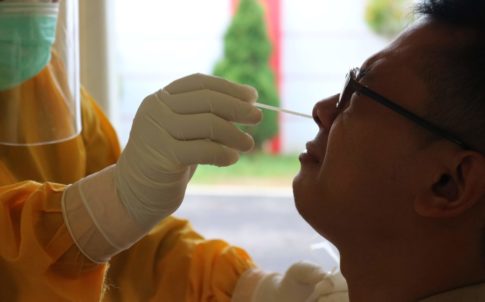Who needs more than four COVID-19 tests per household?

The federal government launched a new website on Wednesday to provide four free at-home COVID-19 tests for every residential address in the United States.
There are many households in the United States with more than four residents living in them. Who are these households and where are they located? We also wanted to learn more about households that may need alternative ways of accessing the material – because they don’t have Internet – or that may need translation.
Free Covid tests by mail are a striking example of a policy that net effect will be almost certainly positive (increased access to testing) but also will almost certainly exacerbate disparities in that same outcome.
— Valerie A. Lewis, PhD (@valeriealewis) January 19, 2022
We looked at several factors, including presence of children, race, Internet access, and language.
Using the 2019* American Community Survey we found that 9.6% of households nationwide have five or more people living in them. (This equals just over 11.8M households.)
Western states were more likely to have households with five or more residents. This share was highest in Utah (18.8%), California (13.7%), Hawaii (13.5%), Idaho (13.2%), and Alaska (12.9%). In contrast, Vermont (4.8%) had the smallest share of households with five or more residents, followed by the District of Columbia (4.9%), Maine (5.7%), Rhode Island (6.5%), and West Virginia (6.7%).
Most households with five or more residents—92% or 10.9M—have children living in them. In half of these households, the youngest child is between the ages of 5 and 17; in 42%, the youngest child is under age 5.
Among households by presence of children, there are five or more residents in:
Overall, 9.6% of households in the United States have 5 or more residents. Nationally, 20% of Hispanic households have 5 or more residents in their household, followed by American Indian (13.5%), Asian (12.9%), Black (9.4%) and White (7.2%). White households were most likely to only have 1-2 people (67.6%) followed by Black households (63.6%). This analysis was based on the racial and ethnic identification of the household head.
The site for COVID-19 tests requires access to the Internet. According to the ACS, 89% of American households have access to the Internet at their house, apartment, or mobile home. Of the 13.4 million households without Internet access at home, 44% of households have a smartphone, laptop, or tablet device that could be used elsewhere.
In total, there are 7.5 million households (6.1% of all households nationally) without Internet and without a smartphone, laptop, or tablet at home.
The Census is available, via web or phone, in 59 different languages. The site for COVID-19 tests is currently available in English and Spanish (and the source code shows that developers are also working on Chinese.) We were curious: What other languages should the developers prioritize for translation?
To do this, we looked at the language spoken by the head of household and focused on households where the head reported limited English abilities (speaking English less than “very well”). There are 9.6 million households with limited English abilities and Spanish was the dominant language among these households (6.1M or 64% of all limited English household heads spoke Spanish). The next most common languages spoken by limited English households were:
Need help understanding population change and its impacts on your community or business? Carolina Demography offers demographic research tailored to your needs.
Contact us today for a free initial consultation.
Contact UsCategories: COVID-19

The Center for Women’s Health Research (CWHR) at the University of North Carolina School of Medicine released the 12th edition of our North Carolina Women’s Health Report Card on May 9, 2022. This document is a progress report on the…

Dr. Krista Perreira is a health economist who studies disparities in health, education, and economic well-being. In collaboration with the Urban Institute, she recently co-led a study funded by the Kate B. Reynolds Foundation to study barriers to access to…

Our material helped the NC Local News Lab Fund better understand and then prioritize their funding to better serve existing and future grant recipients in North Carolina. The North Carolina Local News Lab Fund was established in 2017 to strengthen…
Your support is critical to our mission of measuring, understanding, and predicting population change and its impact. Donate to Carolina Demography today.